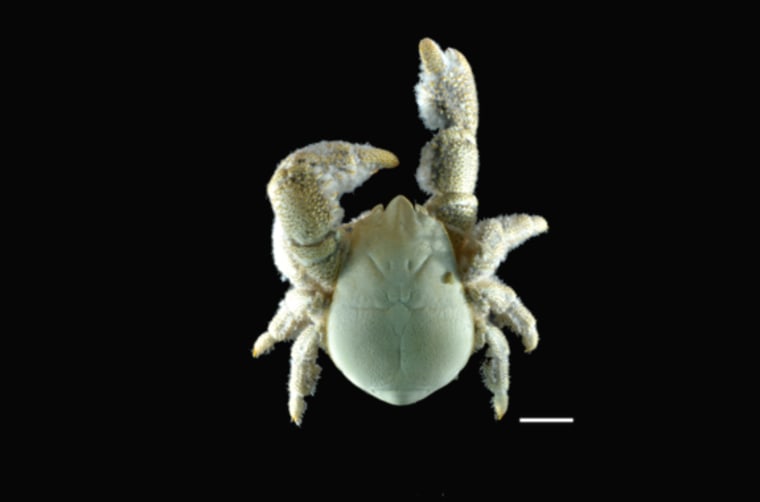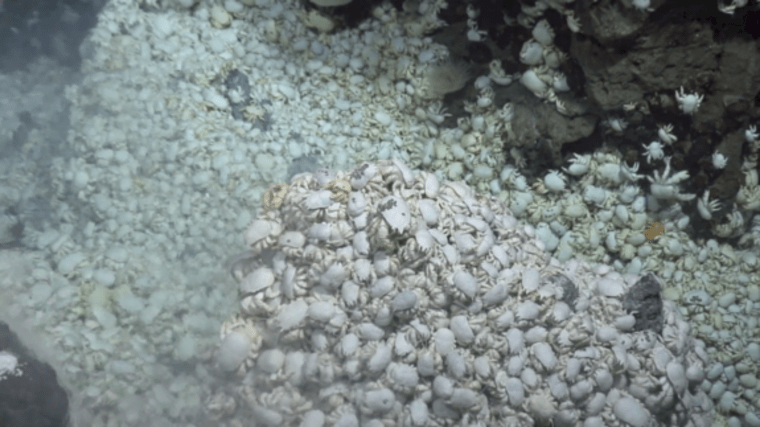What's white and blind and hairy all over? A yeti, of course! Or, in this case, a yeti crab — a marine creature that lives near the thermal vents in the ocean floor where hot water gushes into the sea.
There are three known species of yeti crabs, and now, in a new paper, scientists have described the characteristics of one of these species — Kiwa tyleri — for the first time. K. tyleri is the only species of yeti crab known to reside in the Southern Ocean, off Antarctica.

Researchers first photographed this deep-sea animal in 2010 using a remotely operated submersible vehicle (ROV). But the ROV did more than snap a few pictures of the furry crabs; it also vacuumed up a few specimens from about 8,500 feet beneath the Southern Ocean's icy surface.
Since then, researchers have studied the specimens using genetic sequencing and computed tomography (CT) scanning. Their description of the somewhat strange morphology of the yeti crab was published Wednesday in the journal PLOS ONE.
Many of the yeti crab's distinctive features — like its stark white coloring and its "hairy" body — are the creature's adaptations to its habitat, the researchers said. K. tyleri dwells in a "thermal envelope" of just a few square meters, where the water is just the right temperature, said Sven Thatje, lead author of the report and associate professor of marine evolutionary ecology at the University of Southampton in England.
The crab's tiny habitat in the East Scotia Ridge (located in the Atlantic section of the Southern Ocean, between Antarctica and South America) contains "black smokers," which are chimneylike vents that spew dark water that can reach temperatures of about 720 degrees Fahrenheit. The yeti crabs live right on top of these scorching vents.
The reason for the crabs' tiny living quarters is simple: The water just outside their cozy home is very cold. Water temperatures at that depth of the Southern Ocean typically fluctuate between about 30 and 33 Fahrenheit.
"Crabs and lobsters are very rare in Antarctic/Southern Ocean waters because of the unusually low seawater temperatures," Thatje said.
But some crabs do brave the icy waters away from the vents. Female yeti crabs leave the vents to brood their eggs, which researchers believe need cooler water to develop. The eggs would also be unlikely to survive so close to the hydrothermal vents' sulfur-rich emissions, Thatje said. But these mama yeti crabs have a thankless job — once they are done brooding, they usually die.
"Females that move off-site do not feed; in fact, they starve," said Thatje, who hypothesizes that once the females leave the vents, they aren't strong enough to fight their way back into the crustacean melee.
Yeti crabs survive by growing their own food, in a sense. The distinctive "hair" on their bodies that gives them their name is scientifically known as setae, and serves as a "garden" where the yeti crabs' favorite food — bacteria — grow.

Unlike Kiwa puravida — the yeti crab found near hydrothermal vents off the coast of Costa Rica that has setae only on its appendages — the Antarctic yeti crab also has setae along the underside of its body. The appearance of this "chest hair" led scientists to nickname Kiwa tyleri the "Hoff crab" after "Baywatch" actor David Hasselhoff, who (as you may recall) has a hairy chest.
This is a condensed version of an article that appeared on Live Science. Read the original story here. Follow Elizabeth Palermo @techEpalermo. Follow Live Science @livescience, Facebook & Google+.
MORE FROM LIVE SCIENCE